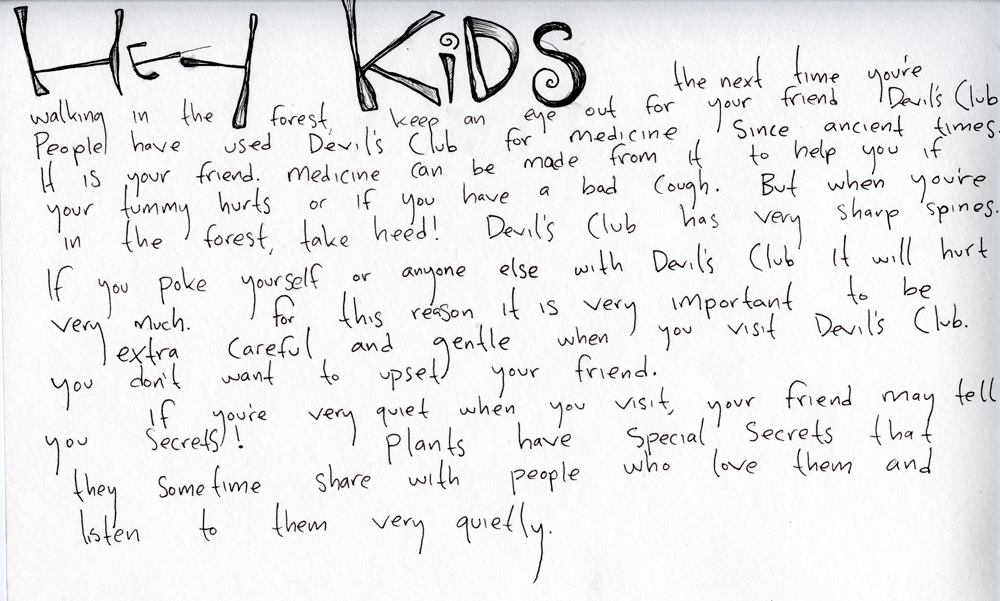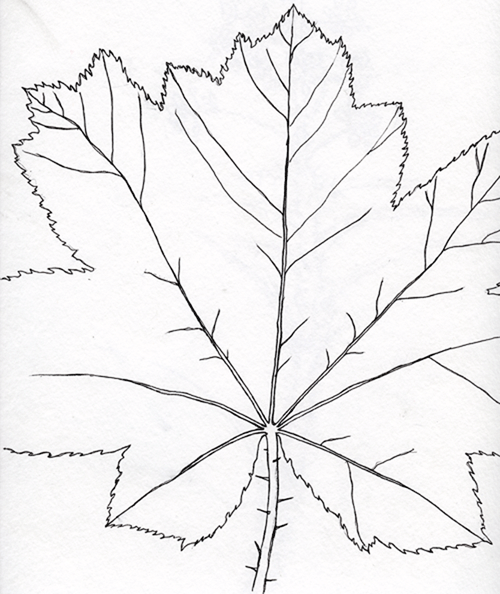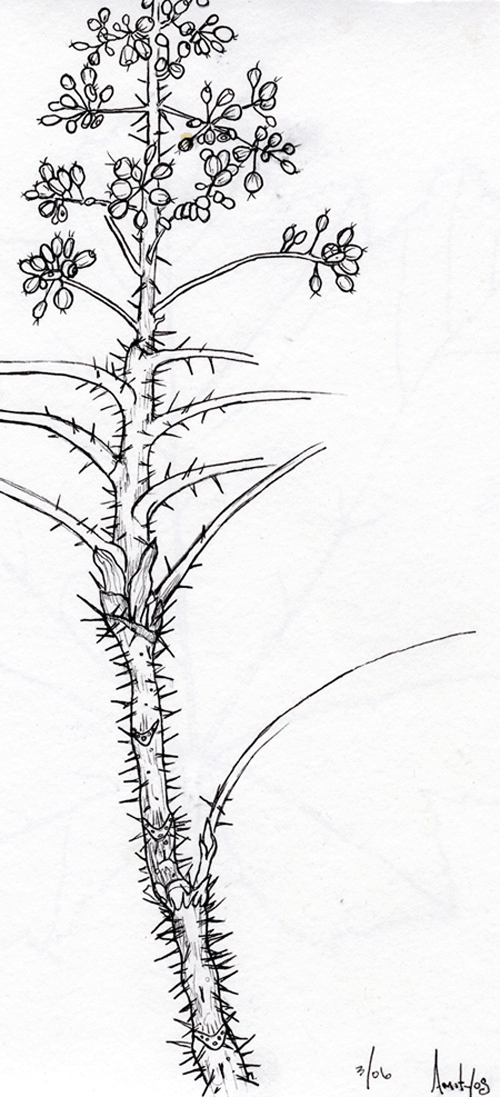Devil’s Club
Family Name: Aralia
Family Name: Araliaceae
Latin Name: Oplopanax horridum/horridus
Also Known as: Fatsia horrida
Lushootseed Name: sxuhdí'ac (3).
Related Species: Eleutherococcus senticosus (Siberian ginseng), Panax quinquefolius (American ginseng), Panax ginseng (Korean/Asian ginseng), Smilax officanlis (sarsaparilla).
Body System Affiliations: Respiratory, Urinary, Digestive, Skin.
___________________________________________________________
Botanical Description:
Habit: Shrub
Size: 4-15 feet tall
Arrangement: Thick, crooked rootstocks, often tangled at base, unbranched.
Leaves: Deciduous, large, and Maple-like, up to 35 cm across, armed with spines along main veins.
Flowers: Small and white, arranged in pyramidal clusters at the top of stem.
Fruit: Bright red, flattened, shiny berries in large compact pyramidal clusters.
Bark: Very thin yellowish layer; protected by extensive spines.
Underground Parts: Rhizomatous stem extension.
__________________________________________________________
Ecology:
Habitat: Moist, rich, well-drained understory; generally near streams or on hills; prefers full to partial-shade.
Range: Forested ecosystems from coastal Alaska southward to northern California, extending eastward to the Northern Rockies of the Yukon, Canadian Rockies, northwestern Alberta, Montana, and Idaho. There are also several disjunct populations near northern Lake Superior in Michigan and Ontario.
Native Where: To these habitats.
Places/Dates Observed/Description: Since I have been a student at Evergreen, I have regularly encountered Devil’s Club in its dormant, leafless, naked state throughout the lower portion of the Evergreen forest (between Driftwood Road and Geoduck Beach). I am surprised at how common this plant is in lowland forests in the Oly/Budd Bay microclimate. Grows in interwoven clusters
___________________________________________________________
Western (European-American) Uses/Relationships:
Medicine:
Part Used: Rhizome
Medicinal Actions: Expectorant, respiratory stimulant, antirheumatic, adaptogen, hypoglycaemic, hyperglycaemic, blood purifier. (7:128, 4, 5).
Indications: Adult onset, insulin-resistant diabetes, rheumatoid arthritis, presence of hard bronchial mucus, disproportionate glucose levels, high blood pressure, body/mind stress. (7:128, 5).
Body System Associations: Respiratory, Urinary, Digestive, Skin.
Constituents: The essential oil of the root contains nerolidol, torreyol, dodinene, bulnesol, dodecenol, cadene, and cedrol, as well as araliasides and panaxosides of varied and unspecified nature. (7:127)
Applications: Fresh tincture, dry tincture, cold infusion.
Preparation: Fresh tincture, 1:2, dry tincture 1:5, 60% alcohol, cold infusion, 1:3 fluid oz.
Pharmacy: Up to three times a day for all applications. (7:127)
Cautions: When harvesting, it is necessary to proceed with supreme awareness and utmost care – the spines of Devil’s Club have an incredible way of lodging in the skin of humans and then breaking into nearly inextractable fragments. These spines are irritants, and will cause an infection if left in the skin for too long.
___________________________________________________________
Indigenous and Non-Western Use/Significance/Relationships:
Materials/Technology: The light colored and lightweight wood has been used by the Klallam, (2:41). Ditidaht, and Nuu-chah-nulth as fishing lures to either attract cod to the surface to be speared, and as weighted bass lures. The stems have been used by the Haida to hook black cod and octopus. (1:82). After the spines have been removed form the bark, it has been mixed in a decoction with berries of Vaccinium and Lonicera spp. for use as a paint and dye in basket making by the Hesquiat (1:82).
Storage: 1-3 foot long pieces of rhizome would be buried near permanent winter dwellings until needed. (4)
Medicine:
Indigenous Group: Taidnapam. (2:41).
Part Used: Stem bark.
Medicinal Actions: Antirheumatic, expectorant, alterative, deodorant.
Indications: Colds, rheumatism, smelliness.
Application: Decoction for colds and rheumatism, pulverizing of dry bark for perfume
Cautions: Devil’s Club is regarded as poisonous and it is believed that the thorns cause inflammation. (2:41)
Indigenous Group: Dena’ina
Part used: Inner bark
Medicinal actions: Antipyretic, alterative, laxative, antitussive, discutient, disinfectant, expectorant
Indications: Ulcers, sores and wounds, respiratory ailments, fever, influenza, tuberculosis (1:82, 5).
Application: poultice, infusion, decoction
Indigenous Group: Lummi. (2:41).
Part used: Bark.
Medicinal Actions: Anagalactogogue, antidandruff, antiparasitic.
Indications: Excessive milk flow, dandruff, lice.
Application: External contact with chest for anagalactogogue actions, rubbing berries in the scalp for lice and dandruff. (1:82, 2:41).
Energetics: Sticks of Devil’s Club are burned and mixed with grease and applied as a protective facepaint during ritual dance. (2:41, 1:82).
Indigenous Group: Haida (5).
Part Used: Inner bark of stem/rhizome
Medicinal Actions: Antirheumatic, purgative, laxative, analgesic, antitussive, discutient, antipyretic, alterative, disinfectant, antiparasitic, tonic, hypoglycaemic, hyperglycaemic, anti-tumor, recovery of skeletal trauma, lithotriptic, psychological homeostasis, others (difficult to specifiy).
Indications: Lice/dandruff, diabetes, rheumatism/arthritis, influenza, fever, tumors, cancer, respiratory ailments, gall stones, insanity, internal infections, wounds, venereal disease, blindness
Application: Infusion, decoction for most, poultice for sores and wounds, beating with stems for insanity (5).
Energetics: Pieces retained in the person or in a domicile for luck, and to protect and purify oneself spiritually (5, 1:82).
Indigenous Group: Skagit (2:41).
Part Used: Bark and rhizome.
Medicinal Actions: Emmenagogue, antitussive, others (difficult to specify).
Indications: Irregularly reluctant menstrual flow, tuberculosis.
Application: Decoction. When treating TB, cascara bark and princess pine were included in the mixture. (2:41).
Indigenous Group: Halq’emeylem
Medicinal Actions: Antiarthritic, tonic, antitussive, deobstruent, antiviral, expectorant, antipyretic, hypoglycaemic, hyperglycaemic, antirheumatic. (5, 1:82)
Indications: Arthritis/rheumatism, measles, respiratory ailments, diabetes.
Application: Infusion or decoction of inner bark, whole stems used to beat rheumatic limbs as counter-irritant.
Energetics: Ashes mixed with grease have been used as a protective facepaint (5, 1:82)
Indigenous Group: Tlingit (5).
Part Used: Inner bark.
Medicinal Actions: Antirheumatic, anti-tumor, purgative, emmenagogue, anagalactogogue, disinfectant, antipyretic, alterative, lithotriptic, laxative, analgesic, antitussive, sores/external infections, astringent, tonic, panacea, discutient, psychological homeostasis, others (difficult to specifiy).
Indications: Pneumonia, ulcers, cancer, influenza, fever, gall stones, rheumatism, irregular menstrual/milk flow during the puerperal period, insanity, internal infections, coughs/colds, wounds/external infections blindness, venereal diseases
Applications: Infusion, decoction for most, poultice for sores and wounds, beating with stems for insanity (5).
Energetics: In addition to behaving as a common charm, Devil’s Club has been used in advanced purification rites and shamanic ceremonies; specifically ceremonies involving weather (5).
***
__________________________________________________________
Propagation: Naturally, Devil’s Club spreads if a piece of the rhizome is buried. Pieces as small as 6 inches have been shown to sprout root and stem come Spring time (4).
Technique: : Similar to harvesting, the idea is to find a healthy branch, locate and uncover the root several feet back from where it turns into the stem, and cut out a portion. As long as this section comes from somewhere near the middle of horizontal root growth, the plant will be able to regenerate and become two plants.
Timing: Soon after the leaves drop seems to be the best time for such behavior
___________________________________________________________
Harvest:
Plant Part: Rhizome
Season of Harvest: Late October to mid March, during its dormant winter stage. It has been said that the best time to harvest for medicine is “in Scorpio, or within one moon after the leaves turn yellow and drop.”(4).
Method of Harvest: As previously stated, a portion of the horizontal underground rhizome, which is usually not more than a few inches beneath the humus, is removed with clippers.
Ecological Considerations of Harvest: It is essential that the piece of root removed be balanced in such a way that it will not impede the healthy growth of the plant with the upright and established stem and that there is sufficient root left for a new plant to begin. Generally, if this condition is met, the stand will continue to thrive. It is of utmost importance to recognize not only the plant itself, but indeed the entire forest as a teacher, lover, and elder. If one does not approach the process of harvesting Devil’s Club with the realization that harvesting must be more reciprocal than simple extraction, injury of the harvester and the plant will probably ensue. It is essential while harvesting to fully cognize and manifest, in the harvester’s personal way, the understanding that Devil’s Club is a powerful and lovely healer and elder. I only feel alright with harvesting because I know that someday it will be my body feeding them...
Cultural Considerations of Harvest: In 1992, signatories to the United Nations Convention on Biological Diversity formally recognized the intellectual property rights of the Earth’s indigenous and traditional peoples in Articles 1 and 8j by calling for fair and equitable sharing of any benefits resulting from the sustainable use of biodiversity and traditional and local knowledge (5). In the case of Devil’s Club and many other culturally important plants, it is clear that commercial medicinal applications and research interest in pharmaceutical applications are based directly on traditional knowledge and use drawn mainly from the ethnobotanical records of indigenous uses. Consequently there is a clear conflict between current commercialization efforts and articles 1 and 8j of the Convention (5). Given this set of circumstances, and indeed the history of this continent, the non-tribal harvesters and users, in a sense, have a definite responsibility to acknowledge, honor, and ask permission from the indigenous (and non-indigenous) people within the intended area of harvest who may depend on the healthy presence of Devil’s Club for their health.
Cautions: It takes a significant amount of dexterity, awareness, and agility not to become a pincushion when harvesting this plant. Due to the presence of formic acid, Devil’s Club thorns are very painful. They are also incredibly difficult to remove, and break apart into tiny fragments once embedded in skin. If they are not removed in their entirety, after a time they will cause a very painful infection. So it is essential to be very precise and aware when interacting with Devil’s Club.
___________________________________________________________
Personal Experience:
Food: I have eaten Devil’s Club. The root has a very potent flavor, and is an acquired taste.
Medicine: I have not yet made medicine for personal medicinal use from Devil’s Club, although I have harvested under the guidance and direction of professional wildcrafter Michael Pilarski.
Part Used: Rhizome
Harvest:
Site Location: Sahale retreat center, near Hood Canal.
Site Description: A shaded streambed in an unmanaged, healthy, diverse second-growth forest. The Devil’s Club stand we took from was in a very secluded and virtually inaccessible place due to a combination of downed trees, moving water, and steep hillsides. The thick canopy provided minimal light exposure. Throughout the forest there were signs of various animal activity such as human, deer, and raccoon. We located plants such as Salmonberry, Red Alder, Western Red Cedar, Maidenhair Fern, Western Hemlock, Douglas Fir, and Sword Fern. We harvested from this stand after asking permission and feeling that it had been granted by the plant.
Technique: We utilized the process described above of carefully removing pieces of the rhizome.
Processing: After cleaning in water, the outer layer of bark was removed by scraping with a non-serrated butter knife
Storage: I did not keep or store the plant.
Experience: The Devil’s Club I ate was potent and flavorful. It gave me a subtle high that lasted for several hours. I felt very connected to the forest. I will NEVER underestimate its powers as a laxative…
Cautions: Be careful, be respectful, be aware, and be loving. Devil’s Club is a powerful being, and in addition to being a healer it can be a fierce, unapologetic guardian. When harvesting, consider Devil’s Club a being that wards off clumsiness.
References Cited:
- Mackinnon, Andy, and Jim Pojar. Plants of the Pacific Northwest Coast. Vancouver, BC: Ministry of Forests and Lone Pine Publishing, 1994.
- Gunther, Erna. Ethnobotany of Western Washington: the Knowledge and Use of Indigenous Plants by Native Americans. Seattle: University of Washington Press, 1945
- Author Unknown. http://www.lushootseed.net/plants.htm. Accessed 2-10-06
- Author Unknown. http://www.herbalgram.org/youngliving/herbalgram/articleview.asp?a=2697. Accessed 2-14-06.
- Moore, Michael. Medicinal Plants of the Pacific West. Santa Fe, NM: Red Crane Books, 2001
Justin Averre - Arts, Environment, and the Child: Walking the Wheel of the Seasons - Winter Quarter - 2006

 GETTING ACQUAINTED WITH YOUR FRIEND Oplopanax horridum
GETTING ACQUAINTED WITH YOUR FRIEND Oplopanax horridum
One of the Pacific Northwest Coast’s most powerful and distinctive plants, Devil’s Club has the interesting capacity to stand as one of the most prominent healers of the bioregion while at the same time being one of the most unforgiving guardians of the forest. Throughout time, Devil’s Club has been highly regarded by and played a prominent role in many of the cultures indigenous to its growth range. It resides in shady, moist places of Cascadia’s most pristine forests. Growing between four to fifteen feet in height, Devil’s Club is characterized by stands of erect, light-colored stems with that sprout large deciduous Maple-like leaves in the Spring. Each stem is crowned with pyramidal clusters of white flowers that mature into red berries. As many a clumsy woodland wanderer can attest, the stem and leaves are bristling with sharp spines that grow up to two inches in length. These spines have an amazing propensity to easily penetrate human skin, where once embedded they break into many small fragments, rendering them nearly inextractable. The spines contain formic acid, the same fiery substance that makes unintentional intimate encounters with Stinging Nettle (Urtica dioica) so much fun. This behaves as a surprisingly painful irritant, and if any portions of the spines remain under the skin for too long, they will cause a painful infection to develop.
One of the many traditional uses of Devil’s Club by the Nations native to the same regions as it has been as a disinfectant for wounds; applied either as a poultice to an infected abrasion or used as a soak. So if one were suffering from the painful infection caused by the thorns of Devil’s Club, one potential medicine would be… Devil’s Club. The inner bark of the subterranean rhizome, which can be accessed from an extracted piece by gently removing the top layer of thin bark, has many medicinal properties. Other prominent uses that continue to this day include internal ingestion and soaking of limbs and appendages affected by rheumatoid arthritis, internal consumption for tuberculosis and other respiratory ailments, calming down a hyperactive thyroid, a very effective purgative, and daily consumption for use as a stimulating adaptogen. It has been shown to be highly effective at maintaining optimum blood sugar levels and can be consumed daily to help stabilize those suffering from adult-onset type II diabetes. Devil’s Club makes wonderful tinctures and decoctions.
Devil’s Club is a wonderful being in many ways. One reason to appreciate this plant is because the quality of relationship one experiences with it depends upon the intentions and attention that are brought to it. If someone is bumbling about in a less-than-fully-conscious manner, there is a potential that they can get hurt very badly by this plant. By the same token, if one seeks this plant out with honor, love, and awareness, it can provide the ability for unparalleled healing… So go forth and love the forest, and this plant. I promise it will return the gesture.